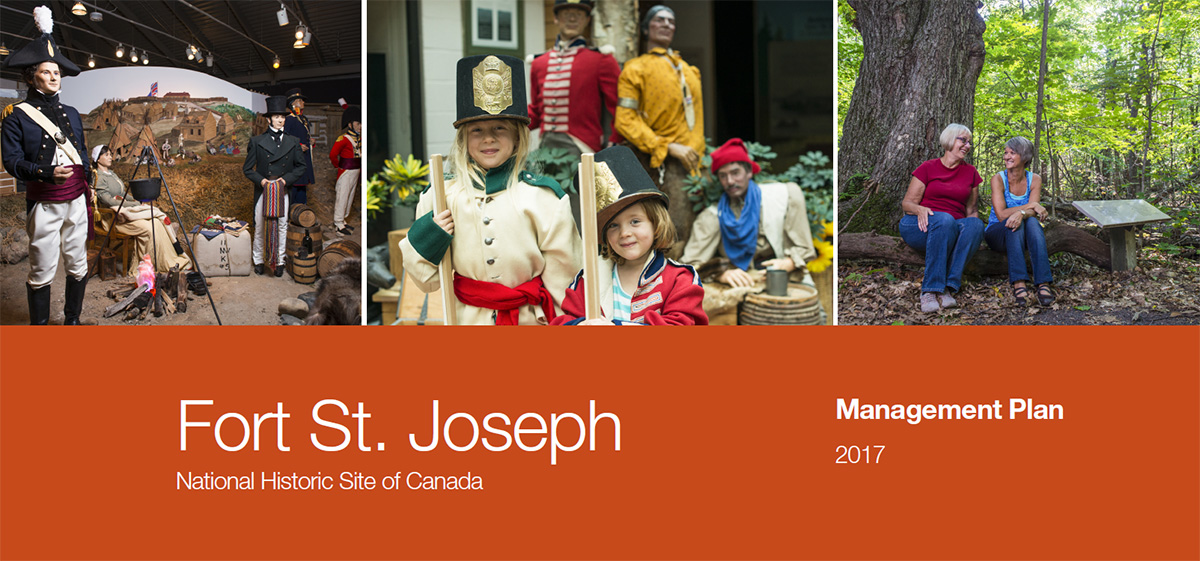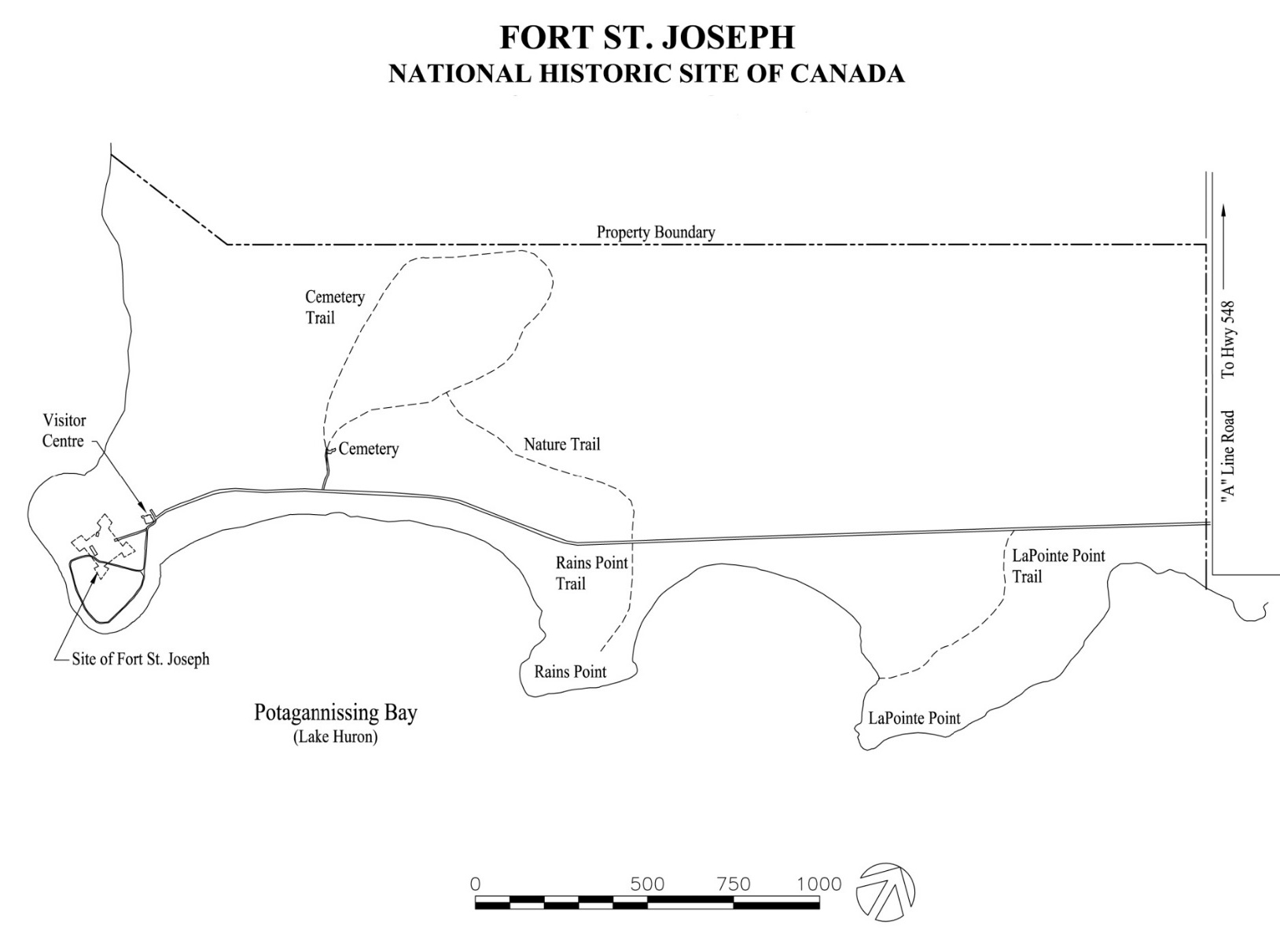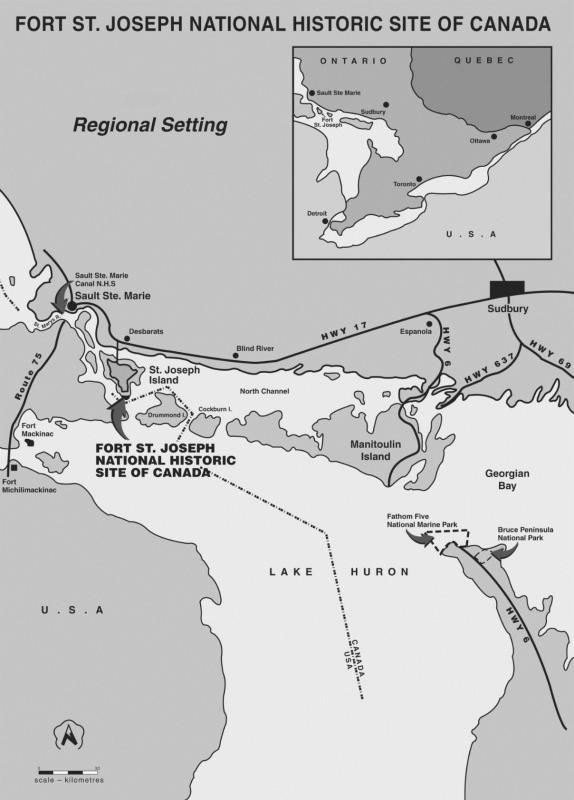Fort St. Joseph National Historic Site of Canada Management Plan 2017
Fort St. Joseph National Historic Site
Table of contents


© Her Majesty the Queen in Right of Canada, represented by the Chief Executive Officer of Parks Canada, 2017.
Cette publication est aussi disponible en français.
Library and Archives Canada Cataloguing in Publication
- Parks Canada
- Fort St. Joseph National Historic Site of Canada management plan, 2017.
Issued also in French under the title:
Lieu historique national du Canada du Fort-St. Joseph, plan directeur, 2017.
Available also on the Internet
- ISBN 978-0-660-03771-4 PDF: 978-0-660-07455-9
- Cat. no. R64-318/2017E PDF: R64-318/2017E-PDF
- Fort Saint Joseph National Historic Site (Ont.) -- Management.
- Historic sites – Ontario -- Management.
- Historic sites -- Canada -- Management. I. Title.
- FC3064.F66 .P3713 2017
For more information about the management plan or about Fort St. Joseph:
P.O. Box 220
Richards Landing ON P0R 1J0
Canada
Front Cover Image Credits
Scot Munn, 2014
Foreword

These special places make up one of the finest and most extensive systems of protected natural and cultural heritage areas in the world.
The Government is committed to preserving our natural and cultural heritage, expanding the system of protected places and contributing to the recovery of species-at-risk. At the same time, we must continue to offer new and innovative visitor and outreach programs and activities so that more Canadians can experience Parks Canada places and learn about our environment, history and culture.
This new management plan for Fort St. Joseph National Historic Site of Canada supports this vision.
Management plans are developed through extensive consultation and input from various people and organizations, including Indigenous peoples, local and regional residents, visitors and the dedicated team at Parks Canada.
National parks, national historic sites and national marine conservation areas are a priority for the Government of Canada. I would like to thank everyone who contributed to this plan for their commitment and spirit of co-operation.
As the Minister responsible for Parks Canada, I applaud this collaborative effort and I am pleased to approve the Fort St. Joseph National Historic Site of Canada Management Plan.
Original signed by
Recommendations
Recommended and original signed by
Daniel Watson
Chief Executive Officer
Parks Canada
Robin Lessard
Field Unit Superintendent
Northern Ontario Field Unit
Parks Canada
Parks Canada
Executive Summary
Fort St. Joseph National Historic Site of Canada, located on the shore of Lake Huron at the southern tip of St. Joseph Island, features the archaeological remains of an eighteenth century British fort. The ruins present a snapshot in time of a remote community in the years leading up to the War of 1812, strengthened by an alliance between the British military, Métis, and First Nations.
Fort St. Joseph boasts strong supporters from the Island townships, close ties to the Ermatinger-Clergue National Historic Site in Sault Ste. Marie and interest among the Indigenous groups in the region. Engagement with Indigenous partners as well as the general public in the preparation of the management plan resulted in the development of three key strategies, several objectives and corresponding targets.
The three key strategies for the ten year management plan focus on the following:
- Raising the profile of Fort St. Joseph by expanding reach;
- Strengthening relationships and diversifying visitor experience opportunities;and
- Conserving and maintaining cultural resources and contemporary assets.
A primary component of plan implementation will be working with others, from local businesses and attractions to destination marketing organizations and Indigenous partners with a goal of collaboration designed to enhance the visitor experience, increase visitation and position the fort as a key regional attraction.
1.0 Introduction
Parks Canada manages one of the finest and most extensive systems of protected natural and historic places in the world. The Agency’s mandate is to protect and present these places for the benefit and enjoyment of current and future generations. Future-oriented, strategic management of each national park, national marine conservation area, heritage canals and those national historic sites administered by Parks Canada supports the Agency’s vision:
“Canada’s treasured natural and historic places will be a living legacy, connecting hearts and minds to a stronger, deeper understanding of the very essence of Canada.”
The Parks Canada Agency Act requires Parks Canada to prepare a management plan for national historic sites administered by the Agency. The Fort St. Joseph National Historic Site of Canada Management Plan, once approved by the Minister responsible for Parks Canada and tabled in Parliament, ensures Parks Canada’s accountability to Canadians, outlining how the management team of this historic site will achieve measurable results in support of the Agency’s mandate.
Various people and organizations, including Indigenous peoples, local and regional residents, and visitors were involved in the preparation of the management plan, helping to shape the future direction of the Fort St. Joseph National Historic Site.
The plan sets clear, strategic direction for the management and operation of the Fort St. Joseph National Historic Site by articulating a vision, key strategies and objectives. Parks Canada will report annually on progress toward achieving the plan objectives and will review the plan every ten years or sooner if required.
This plan is not an end in itself. Parks Canada will maintain an open dialogue on the implementation of the management plan to ensure that it remains relevant and meaningful. The plan will serve as the focus for ongoing engagement on the management of Fort St. Joseph National Historic Site in years to come.
2.0 Significance of Fort St. Joseph National Historic Site
In 1923, Fort St. Joseph was designated as a place of national historic significance because it:
- Symbolizes the commercial and military alliance that existed between the British and the Indigenous peoples of the western Great Lakes region in the aftermath of the American Revolutionary War through the War of 1812;
- Contains a remarkable assemblage of archaeological features which in their undeveloped state reveal part of the complex pattern of military, domestic and commercial life – Indigenous and European – in this frontier outpost; and
- Features ruins of the fortifications and archaeological resources dating from the 1796-1812 period which are considered to be of national significance.
The story of the fort is intertwined with that of forts in the United States. Following the signing of the Jay Treaty in 1794, the British military withdrew from Michilimackinac Island in present-day Michigan and in 1796-99 built a fort on St. Joseph’s Island. What was then the most westerly military post in Upper Canada served as a natural defensive military position and as a landmark for the fur trade and First Nations and Métis communities. The fort was garrisoned from 1796 to 1812, and by including a post of the Indian Department, it also became a trading centre for Indigenous peoples. One of the initial skirmishes at the outset of the War of 1812 involved an expedition organized at Fort St. Joseph that captured the American fort at Michilimackinac on July 17, 1812. The British subsequently abandoned Fort St. Joseph in favour of Michilimackinac and in July 1814 Americans raided Fort St. Joseph and burned it to the ground.
The designated place comprises areas of known archaeological resources relating to the activities of the military garrison and frontier community from 1796 to 1812 at Old Fort St. Joseph Point, Rains Point, and LaPointe Point. It features archaeological resources including the remains of military buildings, defensive works and wharves, and civilian dwellings, store-houses, workshops and wharves dating from 1796 to 1812 that portray the interplay of military, domestic, and commercial life, both Indigenous and European.
3.0 Planning Context
Fort St. Joseph National Historic Site is located on the southern tip of St. Joseph Island, the second largest island in Lake Huron (after Manitoulin Island) and the third largest in the Great Lakes. The island is situated near the mouth of the St. Marys River, which connects lakes Huron and Superior. The island has a permanent population of about 2,000 residents, with the largest towns being Richards Landing in the north, and Hilton Beach on the island’s east side. One bridge links the island to the mainland, connecting to the Trans-Canada Highway just to the north leading directly to Sault Ste. Marie, a city of 75,000 residents approximately 100 kilometres to the west. The character of the island is primarily agricultural in the northwest, with the bulk of the remainder of the island covered by extensive maple hardwood forests. Four townships make up the political administration of the island. Tourism forms the mainstay of the island economy, with lesser contributions from logging, agriculture, and maple syrup production.
The region offers a wide range of leisure and tourism opportunities all year round. In summer, which is the fort’s peak season, beaches and cottages make the island a favoured vacation spot, particularly for residents of Sault Ste. Marie, serving to double the island’s population. A variety of events are held each year focussing on arts, music, and harvest time. Other attractions on the island include the St. Joseph Island Museum featuring six historic buildings and thousands of artifacts, and Adcock’s Woodland Gardens. Several historic buildings including a jail in Richards Landing, may be viewed on walking tours of the communities.
The surrounding region offers many complementary heritage appreciation, tourism and recreational opportunities. Sault Ste. Marie features the Sault Ste. Marie Canal and Ermatinger-Clergue National Historic Sites, the Sault Ste. Marie Museum, the Algoma Central Railway Agawa Canyon train tour and the Canadian Bushplane Heritage Centre. Nearby North Shore communities feature the Timber Village Museum in Blind River and historic attractions such as the Simpson Mine Tour in Bruce Mines. In addition, the Algoma District provides outstanding wilderness experience opportunities. Within the wide array of leisure and tourism experiences offered, Fort St. Joseph offers unique opportunities for discovery, enjoyment and learning.
Building relationships with Indigenous groups is a priority for Parks Canada. Fort St. Joseph is situated within the traditional homelands of several First Nations. It is also historically significant to the Métis. During its 1796 to 1812 operation, the fort was a post of the Indian Department. The unique assemblage of military and trade communities sparked by the nexus of Indigenous, military and fur trade interests created an Indigenous/British alliance whose strength was unmatched elsewhere during Canada’s formative years; indeed, the Indigenous presence is a fundamental reason for the site’s national significance.
Map 1 Fort St. Joseph

Map 2 Regional Setting

This management plan replaces the 2005 Management Plan for Fort St. Joseph National Historic Site, which provided management direction for many improvements to cultural resources, visitor experience and contemporary assets. Since 2005, Fort St. Joseph has improved the protection of cultural resources through the implementation of a Landscape Conservation Maintenance Manual, which involved the removal of trees and vegetation that posed a threat to the ruins. Visitor experience opportunities were enhanced through the involvement of local First Nations and Métis in on-site events and activities. Significant improvements to buildings, roads and facilities included roof and atrium repairs, and rebuilding three kilometres of road and the parking lot. A 2014 State of Site Assessment identified these improvements along with a number of opportunities and challenges that were considered in the development of this plan. These include: the need to increase visitation levels; raise the profile of Fort St. Joseph in the region and beyond; strengthen the relationship with First Nations and Métis; and, conserve and maintain cultural resources and contemporary assets.
4.0 Vision
The vision presented below expresses the future desired state of Fort St. Joseph National Historic Site in 15 years.
Fort St. Joseph National Historic Site welcomes visitors to experience what life was like for the small community of soldiers, civilians, First Nations and Métis people who lived at this isolated outpost two centuries ago. The alliance between the First Nations, Métis and British military is a central theme in the presentation of Fort St. Joseph, and visitors find themselves transported back in time to the place where the War of 1812 began.
Parks Canada staff, partners and a strong community of volunteers passionately animate and share stories of the fort’s rich history with visitors through interactive, engaging activities and special events.
The natural beauty of the fort’s setting on St. Joseph Island truly enhances its archaeological, historical and cultural features. Several kilometers of hiking trails wind through mature maple forests abundant with wildlife and along wetlands surrounding the fort, near the shores of Lake Huron.
Canadians and visitors from abroad can experience the fort through interactive web and social media programs. Visitors can learn about and explore the site using these virtual features that will provide the inspiration and the tools required to plan their first and future visits.
5.0 Key Strategies
Key strategy 1:
From Remote Outpost to ‘Must See’ Attraction
This strategy aims to overcome the seclusion of the site by broadening the scope of public outreach opportunities. Promoting the fort as a ‘must see’ attraction on St. Joseph Island and in the Algoma region, through targeted marketing initiatives with local and regional tourism organizations, will increase Parks Canada’s initial reach. The integration of Fort St. Joseph in island tourism initiatives through partnerships with local townships and community organizations (e.g., Chamber of Commerce) will further enhance this strategy and serve to increase both initial and repeat visitation.
Objective 1.1
Initial and repeat visits are increased through the promotion of Fort St. Joseph in broader tourism initiatives in cooperation with Algoma Kinniwabi Travel Association and other potential partners.
Targets:
- Increase overall visitation by 5% within the next ten years based on 2016-17 visitation levels.
Objective 1.2
Public outreach initiatives are strengthened to improve initial connections, inspire first visits and encourage locals to revisit the fort.
Targets:
- Increase initial connections by 50% over the next 10 years through participation in festivals and events based on an established baseline in 2015-16.
- Increase the profile of Fort St. Joseph in online and print media over the next five years.
Key strategy 2:
Creating 21st Century Alliances and New Fort Experiences
This strategy will serve to engage and increase the number of partners, stakeholders and volunteers at Fort St. Joseph resulting in enhanced visitor experience opportunities through the delivery of programs, services, activities, and special events. Exploring new outdoor recreation opportunities such as hiking, cycling, paddling and birding will also be a focus of this strategy. Collaboration with First Nations and Métis will enhance the way the site’s Indigenous history is shared with visitors through potential initiatives such as cultural experiences and storytelling.
Objective 2.1
The emerging relationship with the Métis Nation of Ontario continues, identifying opportunities for increased Métis participation in on-site activities.
Targets:
- A greater number of onsite programs/events involving Métis compared to 2014/2015.
- Métis Nation of Ontario reports increased engagement with Parks Canada staff at Fort St. Joseph.
Objective 2.2
Opportunities are explored for First Nations involvement at the site with the intent of identifying collaborative initiatives.
Targets:
- Establish a forum for ongoing dialogue and relationship building with local/regional First Nations within the first year of plan approval.
Objective 2.3
Visitor experience opportunities have been implemented with community partners such as the St. Joseph Island Chamber of Commerce and Island Townships, as well as with other local and regional attractions and businesses.
Targets:
- Increased use of the site for special events compared to 2014/15.
- New visitor experience opportunities are implemented involving third parties within five years of plan approval.
Objective 2.4
On site events and programs are enhanced through the recruitment of volunteers by targeting local high school students, Sault College, Island artisans, regional Arts Council, drama societies, re-enactor groups and the public.
Targets:
- A greater number of volunteer opportunities are available compared to 2014/2015.
Key strategy 3:
Preserving the Past and Sustaining the Future
This strategy takes a proactive approach to the conservation of cultural resources and contemporary assets. Deferred maintenance will be a priority for the visitor centre and entrance road, while conservation planning will focus on the archaeological ruins, landscape and landscape features. This strategy will also integrate cultural resource management with the facilitation of visitor experience to create experiences that not only captivate visitors, but contribute to the stewardship of the site’s cultural resources.
Objective 3.1
A conservation and maintenance plan for the ruins, aimed at ensuring that factors causing further deterioration are mitigated, is developed in consultation with Indigenous partners, built heritage professionals and local expertise.
Targets:
- Archaeological sites are rated in ‘good’ condition within 10 years of plan approval.
Objective 3.2
Deferred maintenance items are included on multi-year rolling capital investment plans in order to ensure that the maintenance of contemporary assets is addressed in a timely fashion.
Targets:
- Contemporary assets are rated in ‘good’ condition within 10 years of plan approval.
Objective 3.3
New visitor experiences, integrated with ongoing conservation and preservation practices, are researched and developed.
Targets:
- At least one new visitor experience linked to archaeology is implemented within five years of plan approval.
6.0 Summary of Strategic Environmental Assessment
Parks Canada is responsible for assessing and mitigating the impacts of management actions on ecosystems and on cultural resources. The Cabinet Directive on the Environmental Assessment of Policy, Plan and Program Proposals, prepared by the Canadian Environmental Assessment Agency, requires a strategic environmental assessment of all plans and policies submitted to the federal Cabinet or to a Minister for approval deemed to have important positive or negative environmental effects.
A strategic environmental assessment (SEA) was completed for the Fort St. Joseph National Historic Site Management Plan in accordance with the 2010 Cabinet Directive on the Environmental Assessment of Policy, Plan and Program Proposals. Strategic environmental assessments of management plans provide an opportunity to identify the broad and unintended impacts of proposed management actions, and to assess the cumulative effects of multiple activities on the environment.
The management plan concepts presented have been subject to Indigenous, stakeholder, and public consultation, which has been generally well received. Consultation exercises have led to improvements to the management plan and to strengthening long term relationships.
The SEA evaluated the potential for effects on cultural and natural resources, including species at risk, visitor experience, external relations, and relationships with the Métis and First Nation partners. The implementation of this plan will improve commemorative integrity through initiatives such as: preparing a Ruins Conservation and Maintenance Plan; ensuring that the maintenance of contemporary assets is addressed in a timely fashion and that new visitor experiences are integrated with ongoing conservation and preservation practices.
The management plan identifies several targets as having the potential to result in important positive and/or adverse interactions with the environment including:
- Partnerships to increase the profile of Fort St. Joseph will increase visitation to the site. Increased visitation along with enhanced interpretive programming will increase awareness and understanding of the site’s reasons for designation;
- Collaboration with the Métis and First Nations will enhance relationships and provide an opportunity for mutual benefits; and
- Undertaking deferred maintenance on assets and conservation planning, focused on the archaeological ruins, landscape and landscape features will ensure the site is in good condition.
Impacts to the natural environment and cultural resources are expected to be minimal. Project level assessments will be carried out for projects and activities which may require an environmental impact analysis pursuant to the Parks Canada process for complying with the Canadian Environmental Assessment Act, 2012. In addition, cumulative effects are not anticipated to be significant during the implementation of this management plan.
The implementation of the Fort St. Joseph National Historic Site management plan will also support Canada’s Federal Sustainable Development Strategy and help achieve Theme III, Protecting Nature, Goal 6 Ecosystem/Habitat Conservation and Protection of the 2010 FSDS. Overall, the SEA concluded that the direction proposed in the management plan is consistent with Parks Canada policy and the majority of the proposed actions will result in positive environmental effects to critical factors.
- Date modified :